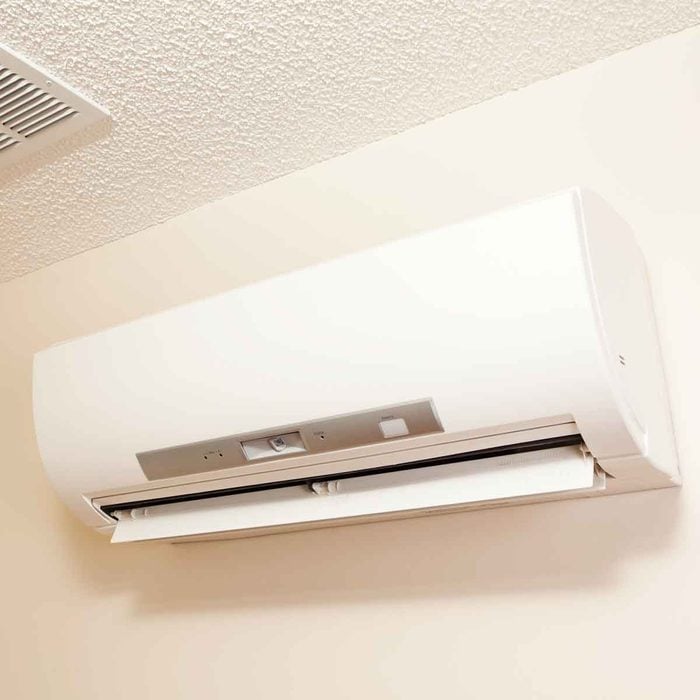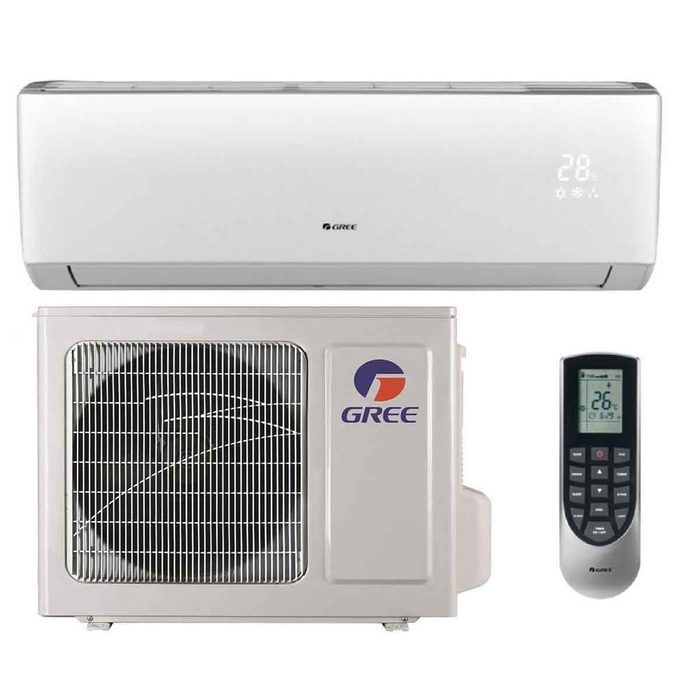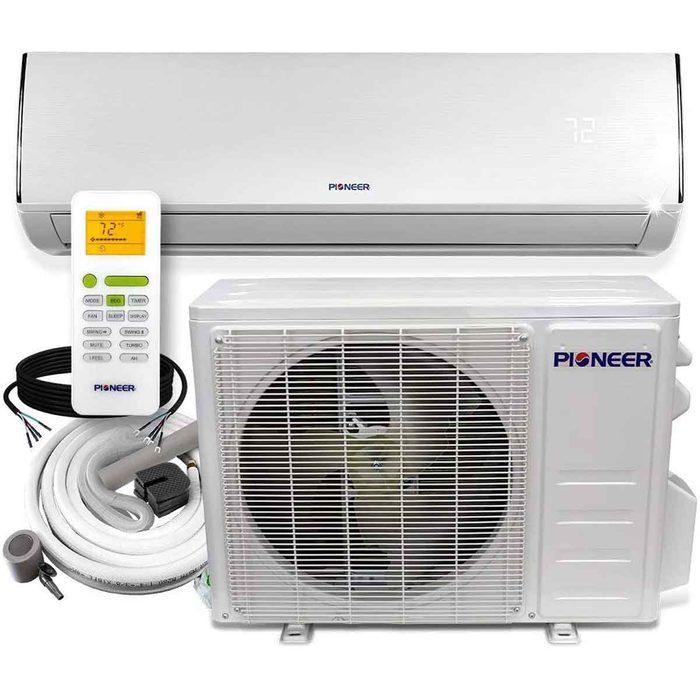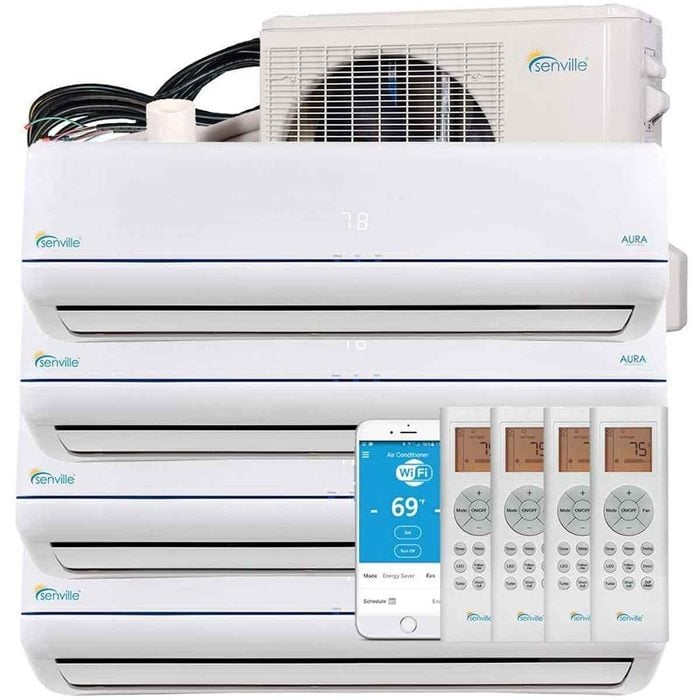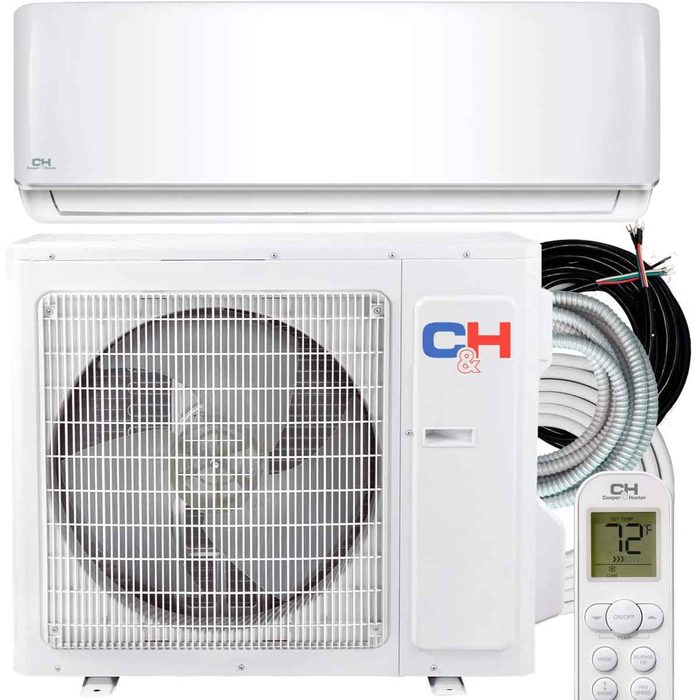 via amazon.com
via amazon.com
While many mini-splits tout the DIY angle for installing, it’s not always easy to mount these 60-plus pound units and charge the refrigeration line. So the designers at Cooper and Hunter made it as simple as possible for the average DIYer to install their ductless air conditioner on the wall.
The Cooper and Hunter Sophia offers a modest 21.5 SEER rating on the 12,000 Btu 115-volt model and a 25 SEER on the 9,000 Btu unit (same price!) 115-volt model.
The DIY installation kit includes a 16-foot pre-flared and insulated copper line set, communication wires, a WiFi smart kit adapter and the indoor and outdoor units. The manual walks you through the simple connection instructions after you drill a hole in the wall for the wires and tubing.
“I was amazed at the quality of this unit,” writes one Amazon reviewer. “Super easy installation and great instructions.”
What to Look for When Shopping for a Ductless Air Conditioner
When shopping for a ductless air conditioner, consider the following:
BTU and Room Size
- 350- to 400-square-foot spaces should have a unit with around 9,000 Btu.
- 400- to 599-square-foot spaces should have a unit with around 12,000 Btu.
- 600- to 1,000-square-foot spaces need a unit with 18,000 Btu.
- 1,001- to 1,300-square-foot spaces would do well with a unit with 24,000 Btu.
Energy Efficiency
The bigger the SEER (Seasonal Energy Efficiency Ratio) and HSPF (Heating Seasonal Performance Factor) numbers, the better. Higher numbers mean better energy efficiency. The minimum SEER is 15, and HSPF is 7. For the most energy-efficient ductless air conditioner, look for a SEER of 20 or higher and an HSPF of 8 or higher.
Energy and Space Compatibility
Though not as significant a project as a ducted system, ductless air conditioners still require the right amount of space and the right energy consumption to function. Ensure you have the space first, then ensure that your home’s electrical system can support the necessary energy output to keep your AC running without shorting out or causing other (potentially dangerous) issues.
Ease of Installation
Typically, HVAC projects (yes, even ductless air conditioners) require professional assistance to install. This means they come with an added cost, but a simple installation can also be cheaper, so keep that in mind. While you may be able to install on your own, ensure you have the proper knowledge and skills before attempting one.
Ease of Cleaning
Because these systems move air through your home, they come with filters. Over time, these filters will accumulate dirt and grime. Before investing in one, ensure you know how hard it is to clean these systems (and replace the filters when necessary).
Smart Features
While not all systems offer smart features or smart home integration, some do. If you already have a smart home system or are considering installing one, check the compatibility of your ductless air conditioner before settling on which system and which air conditioner.
Rebates and Incentives
Some HVAC systems, especially high-efficiency ones, may be eligible for rebates from local utility companies and governments. That means more money back in your pocket. Check with these organizations to find out if you might qualify.
How We Picked the Best Ductless Air Conditioners
As ductless air conditioners are the middle ground between traditional ducted systems and less elegant portable options, we considered them as such. This included keeping an eye on their cost—including both their initial investment and the savings they offer down the line—and paying attention to their styling (nobody likes an eyesore), the difficulty of installation, their ease of use, popularity, user feedback and more. Then, we narrowed it down to a selection offering the best range of budgets (including power consumption) and features for the average homeowner.
Why You Should Trust Us
I’m an award-winning journalist specializing in real estate and home improvements, so this category is the bread and butter of my expertise. It helps, too, that I am based in Las Vegas, where outdoor temperatures often rise well above 100 degrees. Furthermore, my work has been featured in numerous trustworthy publications, including The New York Times, Los Angeles Times, People, Las Vegas Review-Journal, Today’s Parent and dozens of others.
In addition to my experience and expertise, I also consulted Brad Roberson, president of Aire Serv, a Neighborly company and a trusted name in heating and air conditioning installation, maintenance, and repair. He has been working as an expert in the home improvement space for the last seven years, including the last two as Aire Serv’s president.
FAQ
Are ductless air conditioners any good?
While not as efficient as a traditional ducted system, ductless air conditioners excel at creating independent temperature zones. They offer an ideal alternative when a comprehensive ducted system isn’t an option, especially on a room-to-room basis. They’re especially good for smaller, independent spaces like offices, workshops, etc.
What’s the life expectancy of a ductless air conditioner?
With proper care and regular maintenance, ductless air conditioners can last over 20 years, making them a superb value for the money.
What are the disadvantages of a ductless air conditioner?
While great for individual spaces, ductless systems suffer when expected to heat/cool multiple rooms at once, as they are highly centralized. They are also quite large and might not be the prettiest or sleekest equipment. Finally, they tend to have high installation costs (although their value greatly offsets this over time).
Where should you not install a ductless air conditioner/mini-split?
Anywhere air flow might be obstructed, like behind a wall or curtain, will not make an ideal location for one of these systems, as they rely on open space airflow to work properly. It’s also good to place them away from sources of high heat, like fireplaces or in a window with direct sunlight.

